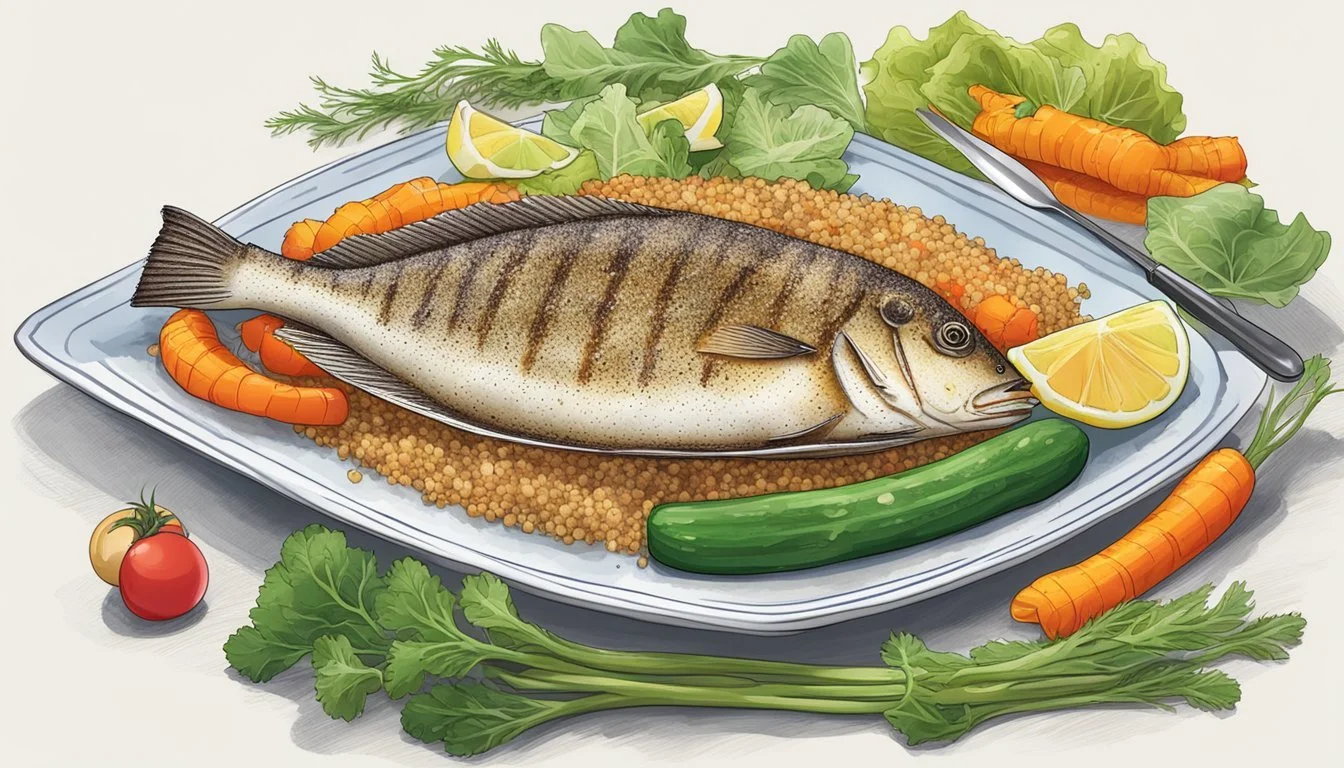Can Diabetics Eat Turbot?
Nutritional Insights and Guidance
Turbot, a nutrient-dense fish, is gaining attention among those managing diabetes. This seafood is packed with essential vitamins such as A, B1, B3, B6, B12, and C, which support overall health. Additionally, it boasts about 16 grams of protein per 100 grams, making it a valuable component of a balanced diet.
For diabetics, incorporating turbot can be particularly beneficial. Turbot contains healthy fats and lean protein, which have minimal impact on blood sugar levels, making it a safe and nutritious choice. Fish like turbot, when eaten in appropriate portions, can play a crucial role in maintaining a healthy diet for managing diabetes.
Incorporating fish into the diet at least twice a week can help diversify nutrient intake while supporting stable blood sugar levels. By including turbot, diabetics can enjoy a delicious and beneficial addition to their meal plans that supports their nutritional needs and aids in diabetes management.
The Nutritional Profile of Turbot
Turbot is a nutrient-dense fish that offers numerous benefits for those managing their diet, particularly diabetics. It is rich in protein, essential vitamins, and minerals, making it an excellent addition to a balanced meal plan.
Macronutrients in Turbot
A 100-gram serving of turbot contains approximately 122 calories, providing a solid source of energy. This portion includes 20.58 grams of protein, which supports muscle maintenance and repair, especially important for diabetics aiming to manage their weight through diet.
Turbot is low in carbohydrates, with net carbs nearly zero. This makes it suitable for those monitoring their blood sugar levels. The fat content in turbot is also favorable, with around 3 grams of fat per serving, primarily composed of healthy unsaturated fats.
Vitamins and Minerals in Turbot
Turbot is rich in various vitamins that bolster the immune system and support overall health. It contains significant amounts of vitamins B1 (Thiamine), B3 (Niacin), B6, B12, and C. These vitamins play crucial roles in energy metabolism, nervous system function, and the synthesis of red blood cells.
The mineral content of turbot is also noteworthy. It provides high levels of potassium, magnesium, and selenium. Potassium is essential for heart health, magnesium supports muscle and nerve function, and selenium acts as an antioxidant, protecting cells from damage.
Protein and Healthy Fats Content
Protein is a major component of turbot, aiding in satiety and weight management. The high biological value of turbot protein makes it an excellent source for muscle protein synthesis, important for diabetics engaging in physical activity.
In terms of fats, turbot contains valuable omega-3 fatty acids, which are known for their anti-inflammatory properties. These healthy fats contribute to cardiovascular health, reducing the risk of heart disease, a common concern for diabetics. The low saturated fat content of turbot also makes it heart-friendly.
Turbot also offers low levels of cholesterol, about 48 milligrams per 100-gram serving, which helps in maintaining healthy cholesterol levels, further benefiting heart health.
Understanding Diabetes and Diet
Effective diabetes management relies heavily on diet. Specific foods impact blood sugar levels, and understanding these effects is crucial for those with diabetes.
Role of Diet in Diabetes Management
Diet plays a critical role in managing diabetes. The right foods can help maintain stable blood sugar levels, while others can cause dangerous spikes. For those managing diabetes, carbohydrates are particularly important because they directly affect blood sugar levels.
Working with a dietitian can help tailor a diet that fits individual needs. Portion control and meal timing are also essential. Eating at regular intervals helps the body better utilize insulin.
Including a mix of macronutrients such as lean protein, healthy fats, and fiber can support blood sugar control. For instance, filling one-quarter of the plate with lean sources like fish or chicken can be beneficial.
How Blood Sugar Levels are Affected by Food
Foods with high glycemic index (GI) values can cause rapid spikes in blood sugar levels. The American Diabetes Association recommends focusing on low to moderate GI foods to maintain stability.
Carbohydrates break down into glucose, raising blood sugar levels. Monitoring carb intake and choosing complex carbohydrates and whole grains can help.
Sugar intake should be limited to prevent hyperglycemia. Processed foods and sugary drinks can lead to high levels of glucose in the blood. Balancing meals with vegetables, lean proteins, and healthy fats can prevent blood sugar spikes.
Proper diet management can make a significant difference in the lives of those with diabetes.
Carbohydrate Considerations for Diabetics
Understanding carbohydrate intake is crucial for managing diabetes effectively. Certain foods impact blood sugar levels more significantly than others, and this can vary between complex and simple carbohydrates.
Carbs in Fish Compared to Other Foods
Fish, including turbot, are naturally low in carbohydrates. This makes them an excellent choice for diabetics aiming to control their blood sugar levels. For instance, a 100-gram serving of turbot contains virtually no carbs, unlike options such as bread, potatoes, and pasta.
Food Comparison:
Turbot (100g): 0g carbs
Bread (100g): ~49g carbs
Potatoes (100g): ~17g carbs
Pasta (100g): ~25g carbs
As fish is a lean protein source, it can help maintain balanced blood sugar without causing spikes. This characteristic positions fish as a beneficial component in a diabetic diet, contrasting sharply with the carbohydrate content of common staple foods.
The Impact of Starches on Blood Sugar
Starches, found in foods like potatoes, rice, and bread, can significantly impact blood sugar levels. They break down into glucose during digestion, leading to increased blood sugar. For diabetics, monitoring starch intake is essential.
Starch Examples:
White Bread: High in refined starches
Potatoes: Contain complex carbs but can still raise blood sugar
Rice: Both white and brown varieties contribute to carbohydrate intake
Including foods high in fiber, such as whole grains and vegetables, can mitigate these effects. Fiber slows the digestion of carbs and helps maintain steady blood sugar levels. Replacing high-starch foods with fiber-rich alternatives can promote better blood sugar control and improve overall diabetes management.
By being mindful of carbohydrate sources and understanding their impacts, diabetics can make informed dietary choices to better manage their condition.
Benefits of Including Fish in a Diabetic Diet
Including fish in a diabetic diet offers multiple health benefits, primarily due to its rich content of healthy fats, high-quality protein, and essential nutrients. Fish can help improve heart health, aid in blood sugar control, and support weight management.
Heart-Healthy Advantages
Many fish, such as salmon, mackerel, and sardines, are high in omega-3 fatty acids. These healthy fats help reduce inflammation and lower the risk of cardiovascular diseases. For diabetics, maintaining heart health is crucial due to their increased risk of heart-related complications.
Including fish in meals can improve cholesterol levels by increasing HDL (good cholesterol) while lowering LDL (bad cholesterol). Studies have demonstrated a connection between fish consumption and a reduced incidence of heart attacks and strokes.
Control of Blood Sugar
Diabetes management heavily relies on maintaining stable blood sugar levels. Fish is an excellent source of lean protein, which does not cause spikes in blood glucose. Protein helps in the slow release of sugar into the bloodstream, allowing for better blood sugar control.
Fish like salmon also contain nutrients that may enhance insulin sensitivity, making it easier for the body to manage glucose levels effectively. Consuming fish regularly can thus contribute to a more balanced and controlled blood sugar profile.
Weight Management and Diabetes
Obesity is a significant risk factor for developing type 2 diabetes, and weight management is essential for diabetes control. Fish is low in calories and high in protein, making it an ideal food for those looking to lose or maintain weight.
Protein-rich foods help in feeling full longer, reducing overall calorie intake. Combining fish with other healthy foods like vegetables and olive oil can support effective weight management and weight loss. Regular exercise complements this diet, further aiding in controlling diabetes and promoting overall health.
In summary, incorporating fish into a diabetic diet can support heart health, blood sugar regulation, and weight management. These benefits collectively contribute to a more balanced and healthier lifestyle for individuals managing diabetes.
Meal Planning with Turbot for Diabetics
Turbot, a nutrient-rich fish, can be a beneficial part of a diabetic meal plan. Specific focus should be placed on incorporating turbot into the Diabetes Plate Method and ensuring appropriate portion sizes to help manage blood glucose levels effectively.
Incorporating Turbot into the Diabetes Plate Method
Using the Diabetes Plate Method, fill half the plate with non-starchy vegetables like broccoli, spinach, or mixed greens. These vegetables offer essential fiber and nutrients without spiking blood sugar levels.
For the protein section of the plate, turbot is an excellent choice. It is a lean fish high in protein and low in unhealthy fats. Cooking methods such as baking, grilling, or steaming are recommended to maintain its nutritional benefits.
Pair the fish with a quarter plate of quality carbohydrates, such as quinoa or lentils. Choose whole grains and legumes to maintain a balanced meal.
Thus, this method helps in regulating blood glucose by providing a structured and balanced approach to meal composition.
Appropriate Portion Sizes
Portion control is crucial in managing diabetes. For turbot, the recommended portion size is approximately 3-4 ounces, which is roughly the size of a deck of cards.
This amount ensures a sufficient intake of protein without overconsumption of calories or fats.
Pair this portion of turbot with 1-2 cups of non-starchy vegetables. A quarter of the plate should include a serving of whole grains or other carbohydrate sources, typically about 1/3 to 1/2 cup cooked.
Careful portion management helps prevent blood sugar spikes and supports ongoing glucose control.
Potential Risks and Considerations
When incorporating turbot into a diabetic diet, it's important to consider specific health factors. These include monitoring sodium levels in fish products and being aware of potential allergies or individual health needs.
Monitoring Sodium and Additives in Fish Products
Many commercially available fish products, including turbot, contain added sodium and preservatives. For individuals with diabetes who also struggle with high blood pressure, consuming high-sodium fish can exacerbate the condition. It's crucial to check nutritional labels for sodium content.
High sodium intake can lead to:
Elevated blood pressure
Increased risk of heart disease
Compromised kidney function
Choosing fresh turbot over processed or prepackaged options can help maintain healthier sodium levels. Cooking methods like baking or grilling are also preferable to frying, which may add unnecessary fats and calories.
Allergies and Individual Health Needs
Fish allergies, although less common, can pose a significant risk. Individuals with known allergies to seafood should avoid turbot and consult with healthcare providers for alternative protein sources.
For those without allergies, the nutritional content of turbot is beneficial. It provides essential vitamins such as B6, B12, and vitamin A without contributing to high blood sugar levels.
However, each individual’s health needs may vary. It is advisable to:
Consult a healthcare provider
Keep track of any adverse reactions
Adjust diet plans as needed
Regular medical check-ups and personalized dietary recommendations can ensure that including turbot in a diabetic diet remains a safe and healthy choice.








